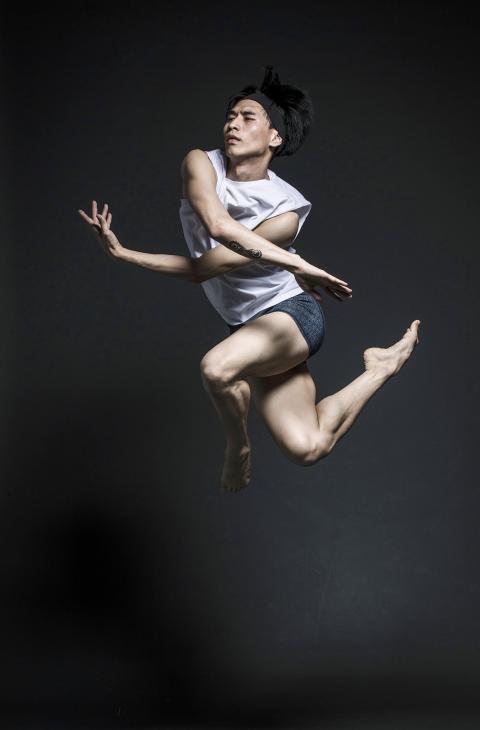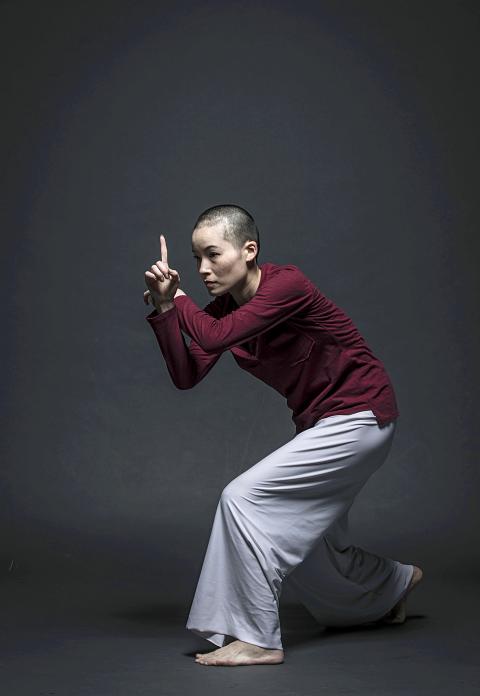The Meimage Dance Company’s New Choreographer Project (鈕扣New Choreographer計畫) show at Taipei’s Huashan 1914 Creative Park last weekend once again demonstrated the power and allure of one of Taiwan’s premier exports — its professional dancers and choreographers.
The project’s seventh edition featured Tung Po-lin (董柏霖), a dancer with London-based Company Wayne McGregor; Liu I-ling (劉奕伶), who is with the New York City-based Bill T. Jones/Arnie Zane Company and Tu Lee-yuan from GoteborgsOperans Danskompani in Sweden.
The program opened with Tung’s reflective solo, Why does he want to leave? (為甚麼他要離開), which began with him seated on the floor at the front of the Umay Theater’s small stage singing and playing guitar, before a short video projected onto the rear wall started.

Photo: Courtesy of Terry Lin
The rather quiet and unconventional beginning to the dance belied the dynamism of Tung’s choreography, which made full use of his arms, precise footwork and ballet training.
It was interesting to reflect how after just a year of working with McGregor, the British choreographer’s penchant for sharply articulated legs, feet and arms appears to be rubbing off on Tung.
Liu’s piece, Gung (更), also saw her singing a bit, but her years in New York, straddling different cultures, both societal and dance, made for a work that began as soft and funny, even wistful, before turning into a provocative dance of assertive empowerment.

Photo: Courtesy of Terry Lin
The transformation was highlighted by the costume change from a very girlish pink dress (with matching shorts), red belt and strappy red sandals that the shaven-headed Liu wore before discarding them in favor of a crimson jersey top and grey sweatpants.
Jones’ sometimes confrontations story-telling style was also reflected in Liu’s piece.
The standout on the program was the final work, Tu’s It Takes Two to Tango, which he performed with one of his Goteborg colleagues, Jan Spotak, a Slovakian-born dancer/choreographer.
There was no singing, at least by the two men, but a lot of comedic and physical interplay based on the pair’s height differential, along with a tea cup and saucer, plus some very fine dancing.
Tu set his piece to a score that ranged from Caetano Veloso’s Cucurrucucu Paloma to Woodkid’s Run Boy Run and Arcade Fire’s Song on the Beach.
It Takes Two to Tango opens with Tu and Spotak kneeling facing one another, one arm raised across their chest and pressed against the other’s, a cup and saucer balanced atop the two limbs.
Their torsos swayed and bodies circled one another without ever losing contact or the cup and saucer, before they effortlessly rose, still locked to one another and the porcelain.
Initially they always stayed in close contact, with Spotak lifting Tu, raising him over his shoulders and around his body, dragging him around or carrying him in his arms like fallen angel.
The pace shifted from slow and relaxed to fast and fluid and Tu also had a chance to manipulate his taller partner.
The alternating dynamics between the pair, their physical exuberance and the playfulness of the choreography made for a very engaging piece and a great introduction to Tu’s works. I would like to see more.
The New Choreographer Project show will be performed in Yilan County tomorrow and Saturday at the Chung Hsing Cultural Creative Park (中興文化創意園區) in Wujie Township (五結). The shows start at 7:30pm and are free.
Last weekend also proved to be a good one for Taiwanese choreographer Benson Tsai (蔡博丞) and his B.DANCE (丞舞製作團隊) troupe, with Tsai scoring yet another win in an international choreographic competition, this time in Switzerland.
First prize at the Tanz-Plattform Bern was awarded to Tsai’s Innermost and L‘aveuglement by the Belgian-based duo of Victor Launay and Sara Olmo, who are collectively known as Les Vikings.
The first place win comes with a commission to create a work about by Albert Einstein for the Dance Company Konzert Theater Bern to premiere in May next year.
The Bern jury praised Innermost’s “colorful, exciting and also humorous choreography.”

This month the government ordered a one-year block of Xiaohongshu (小紅書) or Rednote, a Chinese social media platform with more than 3 million users in Taiwan. The government pointed to widespread fraud activity on the platform, along with cybersecurity failures. Officials said that they had reached out to the company and asked it to change. However, they received no response. The pro-China parties, the Chinese Nationalist Party (KMT) and Taiwan People’s Party (TPP), immediately swung into action, denouncing the ban as an attack on free speech. This “free speech” claim was then echoed by the People’s Republic of China (PRC),

Exceptions to the rule are sometimes revealing. For a brief few years, there was an emerging ideological split between the Democratic Progressive Party (DPP) and Chinese Nationalist Party (KMT) that appeared to be pushing the DPP in a direction that would be considered more liberal, and the KMT more conservative. In the previous column, “The KMT-DPP’s bureaucrat-led developmental state” (Dec. 11, page 12), we examined how Taiwan’s democratic system developed, and how both the two main parties largely accepted a similar consensus on how Taiwan should be run domestically and did not split along the left-right lines more familiar in

As I finally slid into the warm embrace of the hot, clifftop pool, it was a serene moment of reflection. The sound of the river reflected off the cave walls, the white of our camping lights reflected off the dark, shimmering surface of the water, and I reflected on how fortunate I was to be here. After all, the beautiful walk through narrow canyons that had brought us here had been inaccessible for five years — and will be again soon. The day had started at the Huisun Forest Area (惠蓀林場), at the end of Nantou County Route 80, north and east

Specialty sandwiches loaded with the contents of an entire charcuterie board, overflowing with sauces, creams and all manner of creative add-ons, is perhaps one of the biggest global food trends of this year. From London to New York, lines form down the block for mortadella, burrata, pistachio and more stuffed between slices of fresh sourdough, rye or focaccia. To try the trend in Taipei, Munchies Mafia is for sure the spot — could this be the best sandwich in town? Carlos from Spain and Sergio from Mexico opened this spot just seven months ago. The two met working in the